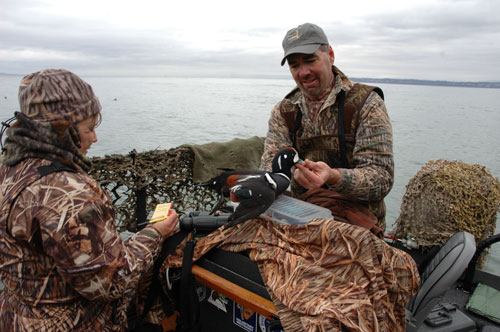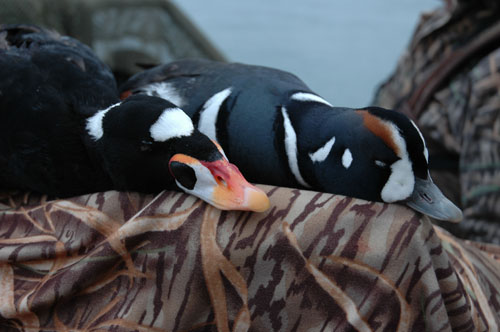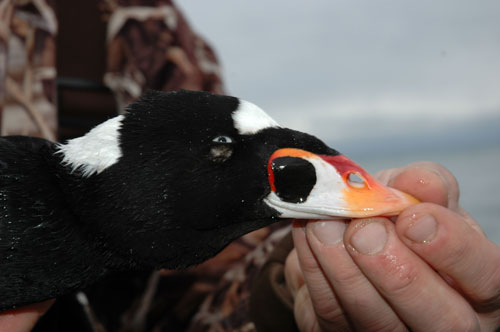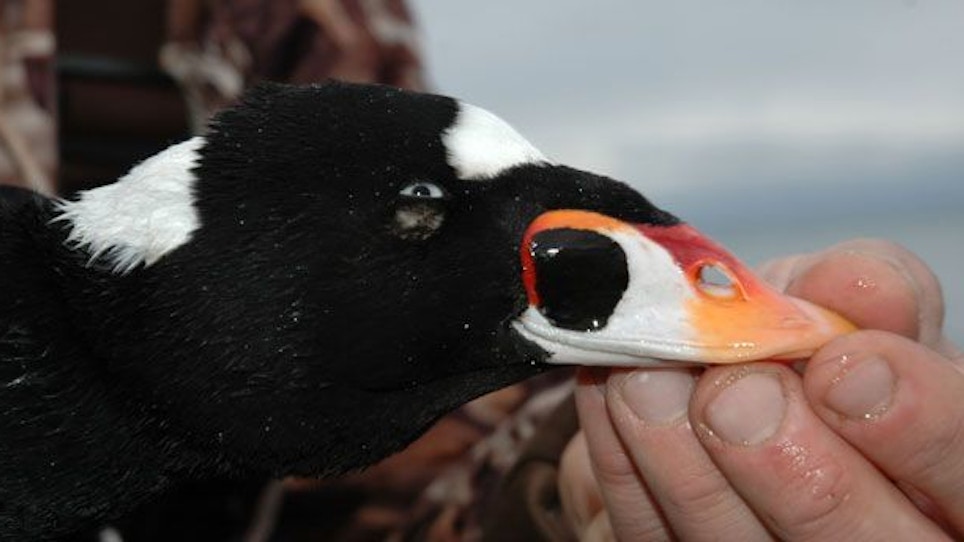 I was raised a puddle duck man by a puddle duck man. I cut my waterfowling eyeteeth, courtesy of the northeastern corner of Ohio, on the late 1970s and early ’80s strong populations of mallards, black ducks, woodies and September blue-wing teal. Divers? Well, divers were something my father and I had read about in magazines, however, the closest we came to being divermen were infrequent meetings with small knots of goldeneyes — called ’em whistlers, just like in the magazines! — on the Mahoning River during our cold-weather second split forays in late December. As for sea ducks, hell, I didn’t know the difference between a scoter and a scooter.
I was raised a puddle duck man by a puddle duck man. I cut my waterfowling eyeteeth, courtesy of the northeastern corner of Ohio, on the late 1970s and early ’80s strong populations of mallards, black ducks, woodies and September blue-wing teal. Divers? Well, divers were something my father and I had read about in magazines, however, the closest we came to being divermen were infrequent meetings with small knots of goldeneyes — called ’em whistlers, just like in the magazines! — on the Mahoning River during our cold-weather second split forays in late December. As for sea ducks, hell, I didn’t know the difference between a scoter and a scooter.
That was all to change, though, with the coming of two events. One, my relocation from Ohio to western Washington in October of 1993, and two, my proximity, a mere 90 minutes eastward, to the Pacific Ocean and the mouth of the Columbia River. It was here on these famous and infamous waters that I was introduced to scoters, a wayward black scoter that fell to my ’fowling piece on the tides not far from the little town of Chinook, WA. It was a spark, albeit small, but I could sense there was something more to the pursuit of these sea-faring ’fowl than I had experienced during some two decades of chasing dabblers. This was followed by an invitation to hunt eiders and oldsquaws, now known by their politically correct moniker, long-tailed ducks, in southern Maine, a call to arms I readily accepted and regretted not in the least. Then it was back across the country to Washington state where, together with my wife, Julia Carol, and good friend and avid sea-ducker, Steve Sutton, I had the pleasure of harvesting my first harlequin. Up to that point, I was of the mind that it was the drake wood duck, Aix sponsa, that was most handsome; the blue duck, the 212-inch typical whitetail of many a waterfowler’s world, quickly had me thinking otherwise.
Today, I’m blessed to have the opportunity, though calling Iowa home, to spend two full months in western Washington each year, two weeks of which are, coincidentally, the final 14 days of The Evergreen State’s duck season. And while I won’t pass up a good mallard shoot or a chance to hang seven mixed baldpate and green-wings on the duck strap, I will go out of my way to spend as much time as possible on the saltwater, eyes scanning that netherworld between sky and waves, for the undulating black waves of traveling scoters, the bat-like maneuvering of a drake harlequin, or the swept-wing silhouettes of lightning-fast long-tails. These are the sea ducks, and for a short period each year, I’m a sea duck hunter. Should you be?
Young by waterfowling veteran standards at 32, Washington native Ben Getty has spent more than half his life in the pursuit of ducks, and much of that on the saltwater. “It was 10 years ago or so,” said Getty, “that I made the switch to sea ducks. Now I still hunt puddle ducks and geese, but today I primarily focus on sea ducks. Why? It offers a totally different experience from hunting puddlers. I find the birds more challenging,” he continued, “and it’s more rewarding and exhilarating when you do harvest one.”
Two years ago, Getty took his saltwater ’fowling passion to the next level when started Getty’s Northwest Guiding, a western Washington-based business not surprisingly founded on sea ducks. “There really aren’t a lot of guiding options available to people for sea ducks,” he said, “At least not in Washington. [Author’s Note – Currently, there are four recognized sea duck outfitters in Washington.] Professionally, I love to be on the water, and introduce people to these birds.”
What are these birds? Getty’s world in the Pacific Northwest offers a wonderful mix of species; however, for gunners seeking all that’s available from a sea duck perspective, there is a trade-off. Washington, for instance, supports excellent populations of scoters, long-tails and goldeneyes, and is the only state in the Lower 48 where harlequins may be harvested. Blue ducks are numerous along portions of the East Coast, but they’re off-limits to hunters. Eiders, absent along the Washington coast save for the occasional and very infrequent wayward individual, represent a bulk of the Atlantic waters’ gunning. And in spots and on days both East and on Lake Michigan, it would seem every long-tail duck on the planet makes an appearance.
Still, a formal introduction to the Sea Duck Clan would be in order.
Scoters
 “We have all three species of scoters here,” said Getty. “Surf, white-wings, and blacks or Americans. We have black scoters, but not in the numbers that we’ll see with surfs or white-wings. The surf scoter is really our bread and butter sea duck; we’ll see flocks in the hundreds on some days. And my hunters like them because they’re relatively reliable, and the shooting can be fast and furious,” he continued.
“We have all three species of scoters here,” said Getty. “Surf, white-wings, and blacks or Americans. We have black scoters, but not in the numbers that we’ll see with surfs or white-wings. The surf scoter is really our bread and butter sea duck; we’ll see flocks in the hundreds on some days. And my hunters like them because they’re relatively reliable, and the shooting can be fast and furious,” he continued.
Personally, I’ve taken all three species in Washington, though the surf has been the most numerous by far. Scoters, like all sea ducks, are tough customers when it comes to absorbing punishment. “For surf scoters,” said Getty, “my favorite load are 3-inch No. 2 steel shotshells. And something fast, like 1,550 feet per second. White-wings are even tougher; BBs aren’t out of the question for them.”
Long-tail ducks
Formerly known as oldsquaws, long-tails are a beautifully handsome bird, partial to deep water — 100-foot plus! My only long-tail to date came via pass-shooting from a series of huge rocks, which the New Englanders who were my hosts called ledges. Here, the black-n-whites flashed down a narrow chute, presenting a shotgunning challenge that made mourning doves look like balloons on a string.
Coveted as a true trophy bird, long-tails, said Getty, are relatively specific when it comes to decoy spreads and hunting locations. “When I have a client who wants to target long-tails,” said the guide, “I’ll set up just for them. Rather, there’s a good chance that’s all we’ll see. I use a minimum two dozen long-tail decoys, and just long-tails. Generally speaking, they don’t mingle with other types of ducks.”
Harlequins
 Though I’ve seen harlequins dozens of times along the Washington coast and on turbulent waters inland, I have hunted the fascinating little bird but once. Within sight of the Canadian border crossing, my wife and I, along with friend and avid sea-ducker Steve Sutton, had the privilege of harvesting two beautiful drakes one dreary January morning. Washington’s harlequin limit, if you’re curious, is one per year; the only other state they’re available is Alaska.
Though I’ve seen harlequins dozens of times along the Washington coast and on turbulent waters inland, I have hunted the fascinating little bird but once. Within sight of the Canadian border crossing, my wife and I, along with friend and avid sea-ducker Steve Sutton, had the privilege of harvesting two beautiful drakes one dreary January morning. Washington’s harlequin limit, if you’re curious, is one per year; the only other state they’re available is Alaska.
When we hunted with Sutton, we set but 13 hand-carved and painted harlequin decoys. Often, our host told, only three or four will be set, and always relatively close to the cobblestone shorelines that the blue ducks frequent as both loafing and feeding areas. Small ducks, roughly the size of a hen woodie, harlequins are taken by those wishing them for the wall. As such, lighter loads — 2-3/4-inch rounds throwing No. 6 bismuth or tungsten-mix — are preferred, as they tend to cause minimal feather disruption.
Eiders
Densely-boned, heavily muscled, and feathered with black-and-white Kevlar, I have in 34 years of waterfowling across the United States never encountered any avian species as difficult to subdue as are eiders. Net a downed bird, shake it, and it’s not unusual to get several of your #BB steel pellets back. “If,” I heard on more than one occasion during my last trip to Penobscot Bay, Maine, “eiders were the size of Canadas, I’m not sure you’d ever kill one.” Exaggeration? Perhaps, but from what I’ve seen, it’s really not too far from the truth.
Themselves fascinating, sea ducks are hunted in places that relatively few gunners have the great fortune to see and experience. To me, the pursuit of scoters, eiders, harlequins and long-tails is as much about where these birds live as it is the finality of having one in hand. “Sea duck hunting,” said Getty, “isn’t something one decides to do overnight. The equipment — the boats, the decoys, the accessories — is quite extensive, moreso than with hunting puddle ducks. Then there’s water, the tides, the safety aspects. I can’t say enough about using common sense out there,” he continued. “It’s a totally different ballgame out there on the saltwater.”
And the young man’s absolutely right — sea duck hunting is totally different. But perhaps it’s time you tried something different, eh?






